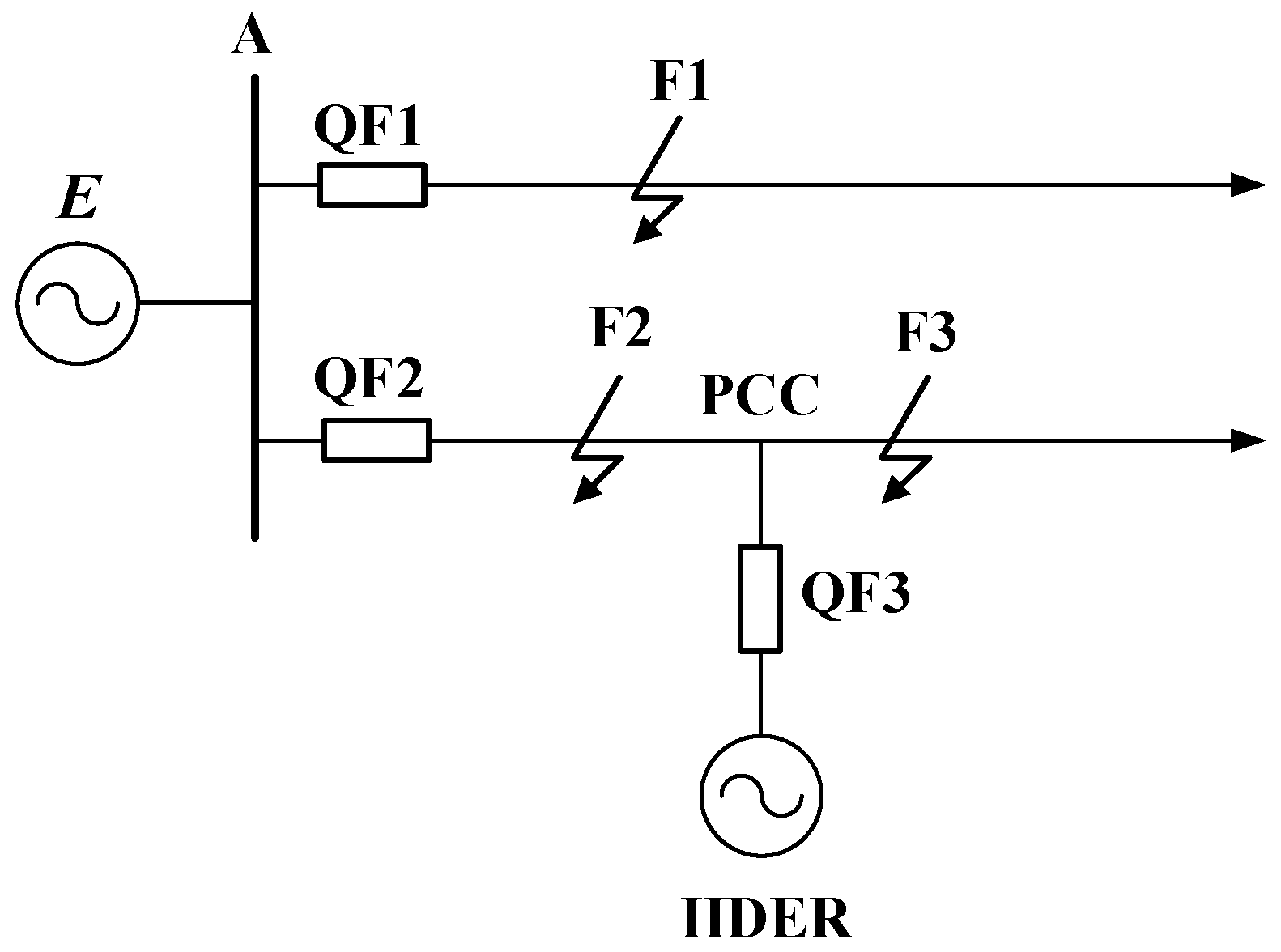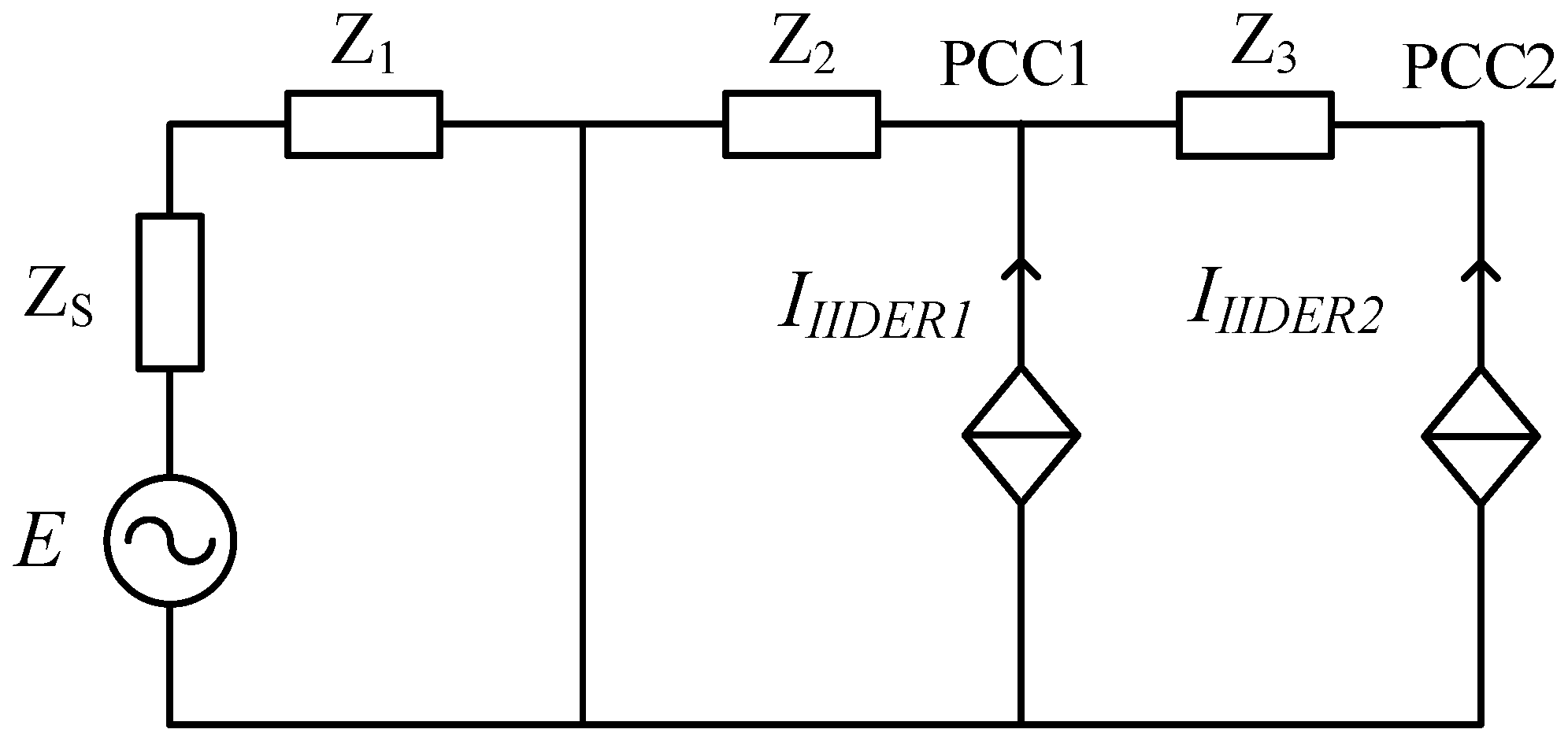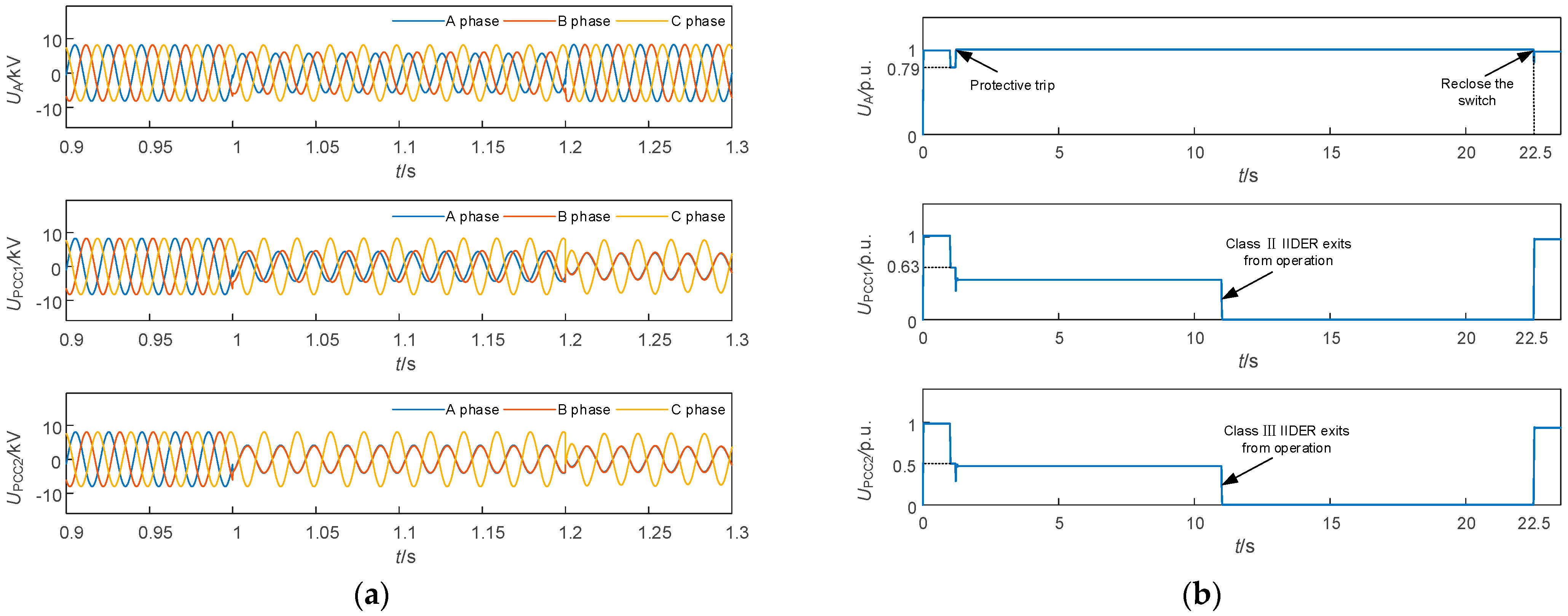A Time-Limited Adaptive Reclosing Method in Active Distribution Networks Considering Anti-Islanding Protection
Abstract
:1. Introduction
2. Influence of IIDERs on the Automatic Reclosing of Distribution Lines
2.1. Effect on Automatic Reclosing
2.2. Coordination Between AIP and Automatic Reclosing
3. Principle of the Time-Limited Adaptive Reclosing Method
3.1. Analysis of the Scenario Where the Arc at the Fault Point Does Not Extinguish
3.1.1. Fault in Feeder 2
- (1)
- The Line Head Fault
- (2)
- The Mid-line Fault
- (3)
- The Line End Fault
3.1.2. Fault in Feeder 1
3.2. Fault Point Arc Extinction
4. Implementation of Time-Limit Adaptive Reclosing
- (1)
- When the distribution line fails, both the main network side and the IIDERs simultaneously inject current into the fault point.
- (2)
- When the line outlet protection detects a fault, the protection action is to trip, and the IIDER connected to the distribution line carries out LVRT in accordance with the requirements for LVRT.
- (3)
- After the protection trip, automatic reclosing starts. The reclosing controller obtains the bus-V before the protection trip. The LVRT requirement of the IIDERs connected to the line has already been configured in the reclosing controller.If the capacity of IIDER meets the self-extinguishing condition, take the action time of anti-island protection as and skip to step (6); otherwise, go to step (4).
- (4)
- Set the reclosing waiting time based on the busbar voltage and the IIDER’s LVRT requirements.
- (5)
- Based on the results of Step (4), allocate the LVRT time for IIDER according to the bus-V, and ensure that all IIDERs are disconnected from the network when the designated time is reached.
- (6)
- To ensure reliability, the reclosing time is extended by 0.3 s based on the reclosing waiting time, accounting for the time consumed by circuit breaker resumption and arc quenching. Then, the required action waiting time for the final reclosing iswhere is the reclosing operation time and is the extended time, taking 0.3 s.
- (7)
- Preset delay time is up, reclosing action, control circuit breaker coincidence.
5. Simulation Verification
6. Conclusions
Author Contributions
Funding
Data Availability Statement
Conflicts of Interest
References
- Yousaf, M.; Jalilian, A.; Muttaqi, K.M.; Sutanto, D. An Adaptive Overcurrent Protection Scheme for Dual-Setting Directional Recloser and Fuse Coordination in Unbalanced Distribution Networks With Distributed Generation. IEEE Trans. Ind. Appl. 2022, 58, 1831–1842. [Google Scholar] [CrossRef]
- Wheeler, K.A.; Elsamahy, M.; Faried, S.O. A Novel Reclosing Scheme for Mitigation of Distributed Generation Effects on Overcurrent Protection. IEEE Trans. Power Deliv. 2018, 33, 981–991. [Google Scholar] [CrossRef]
- Abbaspour, E.; Fani, B.; Sadeghkhani, I.; Alhelou, H.H. Multi-Agent System-Based Hierarchical Protection Scheme for Distribution Networks With High Penetration of Electronically-Coupled DGs. IEEE Access 2021, 9, 102998–103018. [Google Scholar] [CrossRef]
- Sahebkar Farkhani, J.; Najafi, A.; Zareein, M.; Godina, R.; Rodrigues, E.M.G. Impact of Recloser on Protecting Blind Areas of Distribution Network in the Presence of Distributed Generation. Appl. Sci. 2019, 9, 5092. [Google Scholar] [CrossRef]
- Xu, B.; Li, T.; Xue, Y. Relaying Protection and Automation of Distribution Networks; Electric Power Press: Beijing, China, 2017. [Google Scholar]
- Yuehua, W.U.; Houlei, G.; Bin, X.U.; Gengqiang, K.; Zhigang, W.; Ning, W. Distributed fault self-healing scheme and its implementation for active distribution network. Autom. Electr. Power Syst. 2019, 43, 140–146. [Google Scholar]
- Xianglian, Y.; Weijiang, C.; Ziming, H. Experimental research on self-extinction behavior of arc caused by single-phase earth fault in 10kV distribution network. Power Syst. Technol. 2008, 32, 25–28+34. [Google Scholar]
- Yousaf, M.; Muttaqi, K.M.; Sutanto, D. Improvement of Transient Stability of the Power Networks by an Intelligent Autoreclosing Scheme in the Presence of Synchronous-Based DGs. IEEE Trans. Ind. Appl. 2022, 58, 1783–1796. [Google Scholar] [CrossRef]
- Han, B.; Li, H.; Wang, G.; Zeng, D.; Liang, Y. A Virtual Multi-Terminal Current Differential Protection Scheme for Distribution Networks With Inverter-Interfaced Distributed Generators. IEEE Trans. Smart Grid 2018, 9, 5418–5431. [Google Scholar] [CrossRef]
- Jian, L.; Tao, L.; Long, L.; Bingbing, S.; Xiangqian, T.; Zhihua, Z. Adaptability of distribution automation systems to photovoltaic installation. Power Syst. Prot. Control 2014, 42, 7–12. [Google Scholar]
- IEEE Std 1547TM-2018; IEEE Standard for Interconnection and Interoperability of Distributed Energy Resources with Associated Electric Power Systems Interfaces Standard. IEEE: Piscataway, NJ, USA, 2018.
- Zhang, T.; Cao, W.; Zhao, J. A new islanding cutting off strategy based on complex priority index. In Proceedings of the 43rd Annual Conference the IEEE Industrial Electronics, Madrid, Spain, 14–17 October 2017; pp. 2350–2355. [Google Scholar]
- Martínez-Lucas, G.; Sarasúa, J.I.; Sánchez-Fernández, J.Á.; Wilhelmi, J.R. Frequency control support of a wind-solar isolated system by a hydropower plant with long tail-race tunnel. Renew. Energy 2016, 90, 362–376. [Google Scholar]
- Lin, D.; Wang, H.; Lin, D.; He, B. An adaptive reclosure scheme for parallel transmission lines with shunt reactors. IEEE Trans. Power Deliv. 2015, 30, 2581–2589. [Google Scholar] [CrossRef]
- Xie, C.; Li, F. Adaptive comprehensive auto-reclosing scheme for shunt reactor-compensated transmission lines. IEEE Trans. Power Deliv. 2020, 35, 2149–2158. [Google Scholar] [CrossRef]
- Xu, K.; Zhang, Z.; Lai, Q.; Yin, X.; Liu, H.; Liu, W. Study on Three-Phase Reclosing Strategy Applicable to Tie Line of Photovoltaic Power Station. IEEE Access 2020, 8, 36997–37013. [Google Scholar] [CrossRef]
- Choi, J.-H.; Nam, S.-R.; Nam, H.-K.; Kim, J.-C. Adaptive protection schemes of Distributed Generation at distribution network for automatic reclosing and voltage sags. In Proceedings of the IEEE International Conference on Sustainable Energy Technologies, Singapore, 24–27 November 2008; pp. 810–815. [Google Scholar]
- Seo, H.-C.; Ko, Y.-T.; Rhee, S.-B.; Kim, C.-H.; Aggarwal, R.K. A novel reclosing algorithm considering the recovery time of a superconducting fault current limiter in a distribution system with distributed generation. In Proceedings of the 10th IET International Conference on Developments in Power System Protection, Manchester, UK, 29 March–1 April 2010; pp. 1–5. [Google Scholar]
- Ishchenko, D.; Oudalov, A.; Stoupis, J.; Mohagheghi, S. Adaptive auto-reclosing based on DER connectivity data with IEC 61850. In Proceedings of the IEEE Power & Energy Society General Meeting, National Harbor, MD, USA, 27–31 July 2014; pp. 1–5. [Google Scholar]
- International Standard IEC 61850-7-4; Communication Networks and Systems in Substations–Part 7-4: Basic Communication Structure for Substation and Feeder Equipment–Compatible Logical Node Classes and Data Classes, Second Edition. IEC: Geneva, Switzerland, 2010.
- Yuqiang, L.; Zhiwen, W.; Weiqing, W.; Qin, C. Influence of PV with LVRT capability access to distribution network on automatic reclosing and its countermeasures. Power Syst. Prot. Control 2016, 44, 61–67. [Google Scholar]
- Seo, H.C.; Kim, C.H. An Adaptive Reclosing algorithm considering distributed generation. Int. J. Control Autom. Syst. 2008, 6, 131–140. [Google Scholar]
- Xiaojing, D.; Zhao, X.; Rixin, Y. Influence of 10 kV DG Integration on Relay Protection in Distribution Network. Smart Power 2019, 47, 117–122. [Google Scholar]
- Zheng, X.; Chao, C.; Weng, Y.; Ye, H.; Liu, Z.; Gao, P.; Tai, N. High-Frequency Fault Analysis-Based Pilot Protection Scheme for a Distribution Network With High Photovoltaic Penetration. IEEE Trans. Smart Grid 2023, 14, 302–314. [Google Scholar] [CrossRef]
- Li, Y.; Song, G.; Wang, W.; Cao, Q. Permanent fault identification method based on parameter identification for photovoltaic access to distribution network. Power Syst. Prot. Control 2017, 45, 1–7. [Google Scholar]
- Yuan, B.; Zhang, B.; Hao, Z.; Zhang, J.; Wang, X.; Bo, Z. A study on auto-reclosing strategy for large-scale wind farm transmission line. In Proceedings of the 2014 International Conference on Power System Technology, Chengdu, China, 20–22 October 2014; pp. 2827–2832. [Google Scholar]
- Aloghareh, F.H.; Shams, M.; Jannati, M. An efficient deep learning based scheme for adaptive auto-reclosing in power transmission lines. Alex. Eng. J. 2024, 102, 327–338. [Google Scholar] [CrossRef]
- Coffele, F.; Booth, C.; Dyśko, A. An Adaptive Overcurrent Protection Scheme for Distribution Networks. IEEE Trans. Power Deliv. 2015, 30, 561–568. [Google Scholar] [CrossRef]
- Zhang, H.; Li, Y. Short-circuit current analysis and current protection setting scheme in distribution network with photovoltaic power. Power Syst. Technol. 2015, 39, 2327–2332. [Google Scholar]
- Wang, C.; Xu, H.; Yang, F.; Yang, Z.; Chen, H.; Chen, Y.; Xu, B. Anti-islanding protection technology and development of distribution systems. Distrib. Util. 2023, 11, 2–8+22. [Google Scholar]









| Acronym | Full Name | Acronym | Full Name |
|---|---|---|---|
| DER | distributed energy resource | AIP | anti-islanding protection |
| IIDER | inverter-interfaced distributed energy resource | LVRT | low voltage ride through |
| TLAR | time-limited adaptive reclosing | DN | distribution network |
| PCC | point of common coupling | SC-cur. | short-circuit current |
| 3PSC | three-phase short-circuit | AP | access point |
| SSP | system-side protection | bus-V | bus voltage |
| LSVT | line-side voltage transformer | 2PSC | two-phase short circuit |
| Class I IIDER Trip Time | ||||
|---|---|---|---|---|
| Shall Trip Function | Default Setting | Ranges of Allowable Settings | ||
| Voltage (p.u.) | Clearing Time (s) | Voltage (p.u.) | Clearing Time (s) | |
| UV1 | 0.70 | 2.0 | 0.0–0.88 | 2.0–21.0 |
| UV2 | 0.45 | 0.16 | 0.0–0.50 | 0.16–2.0 |
| Class II IIDER Trip Time | ||||
|---|---|---|---|---|
| Shall Trip Function | Default Setting | Ranges of Allowable Settings | ||
| Voltage (p.u.) | Clearing Time (s) | Voltage (p.u.) | Clearing Time (s) | |
| UV1 | 0.70 | 10.0 | 0.0–0.88 | 2.0–21.0 |
| UV2 | 0.45 | 0.16 | 0.0–0.50 | 0.16–2.0 |
| Class III IIDER Trip Time | ||||
|---|---|---|---|---|
| Shall Trip Function | Default Setting | Ranges of Allowable Settings | ||
| Voltage (p.u.) | Clearing Time (s) | Voltage (p.u.) | Clearing Time (s) | |
| UV1 | 0.88 | 21.0 | 0.0–0.88 | 21.0–50.0 |
| UV2 | 0.50 | 2.0 | 0.0–0.50 | 2.0–21.0 |
| Fault Type | IIDER Offline Time/s | Reclosing Time/s | |
|---|---|---|---|
| IIDER1 | IIDER2 | ||
| F1 2PSC | 10 | 10 | 21.3 |
| F1 3PSC | 0.16 | 0.16 | 2.3 |
| F2 2PSC | 10 | 10 | 21.3 |
| F2 2PSC | 0.16 | 0.16 | 21.3 |
| Fault Type | Bus-V Before SSP/p.u. | Voltage of PCCs Before the SSP Action/p.u. | Voltage of PCCs After the SSP Action/p.u. | ||
|---|---|---|---|---|---|
| IIDER1 | IIDER2 | IIDER1 | IIDER2 | ||
| F1 2PSC | 0.607 | 0.518 | 0.515 | 0.451 | 0.452 |
| F1 3PSC | 0.192 | 0.042 | 0.061 | 0.042 | 0.061 |
| F2 2PSC | 0.790 | 0.631 | 0.503 | 0.482 | 0.469 |
| F2 3PSC | 0.640 | 0.246 | 0.015 | 0.019 | 0.015 |
Disclaimer/Publisher’s Note: The statements, opinions and data contained in all publications are solely those of the individual author(s) and contributor(s) and not of MDPI and/or the editor(s). MDPI and/or the editor(s) disclaim responsibility for any injury to people or property resulting from any ideas, methods, instructions or products referred to in the content. |
© 2024 by the authors. Licensee MDPI, Basel, Switzerland. This article is an open access article distributed under the terms and conditions of the Creative Commons Attribution (CC BY) license (https://creativecommons.org/licenses/by/4.0/).
Share and Cite
Yang, F.; Chen, H.; Fan, K.; Xu, B.; Chen, Y.; Cai, Y.; Yang, Z. A Time-Limited Adaptive Reclosing Method in Active Distribution Networks Considering Anti-Islanding Protection. Processes 2024, 12, 2781. https://doi.org/10.3390/pr12122781
Yang F, Chen H, Fan K, Xu B, Chen Y, Cai Y, Yang Z. A Time-Limited Adaptive Reclosing Method in Active Distribution Networks Considering Anti-Islanding Protection. Processes. 2024; 12(12):2781. https://doi.org/10.3390/pr12122781
Chicago/Turabian StyleYang, Fan, Hechong Chen, Kaijun Fan, Bingyin Xu, Yu Chen, Yong Cai, and Zhichun Yang. 2024. "A Time-Limited Adaptive Reclosing Method in Active Distribution Networks Considering Anti-Islanding Protection" Processes 12, no. 12: 2781. https://doi.org/10.3390/pr12122781
APA StyleYang, F., Chen, H., Fan, K., Xu, B., Chen, Y., Cai, Y., & Yang, Z. (2024). A Time-Limited Adaptive Reclosing Method in Active Distribution Networks Considering Anti-Islanding Protection. Processes, 12(12), 2781. https://doi.org/10.3390/pr12122781





